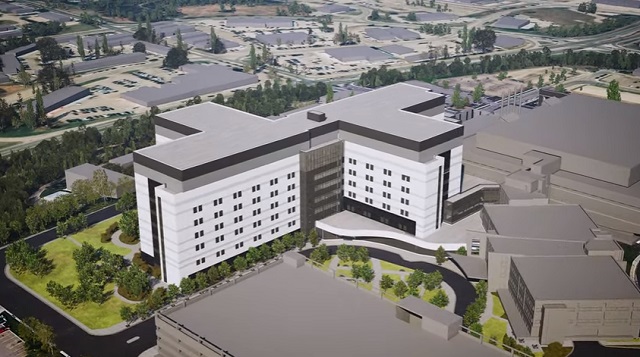Alberta
Red Deer Hospital preliminary designs unveiled

Alberta’s government shared preliminary designs of the Red Deer Regional Hospital Centre redevelopment with residents from central Alberta.
On March 14, Alberta’s government held its first public information session since January 2023 with Albertans in Red Deer and area about the Red Deer Regional Hospital Centre redevelopment. Albertans have long waited for the redevelopment and Alberta’s government made the first significant commitment and progress on the hospital by allocating $100 million in Budget 2020, followed by another $1.8-billion commitment in Budget 2022.
In addition to preliminary design drawings, residents were able to view a video simulating a flyover of the new patient tower and power plant. Project representatives were also on hand to speak about the project. The session was attended by about 150 residents, media and officials including Ken Johnston, mayor of Red Deer.
“We were excited to share preliminary designs for the Red Deer Hospital redevelopment yesterday. The number of people who attended the session validates the importance of this project to the central region. We are proud of the role Infrastructure is playing in delivering one of the most ambitious hospital redevelopment projects in Alberta’s history.”
“As the MLA for Red Deer-North and the Health Minister, I’m very proud of the progress we’ve achieved, and I remain dedicated to advocating for this project. Albertans should be able to access health care when and where they need it. This project will improve health outcomes for Albertans living in Red Deer and across central Alberta by increasing the facility’s capacity and providing much-needed services and resources, including new cardiac catheterization labs, close to home.”
Design work began in June 2023. With schematic design now complete, the hospital redevelopment is on schedule and on budget. The next stage of the project, design development, is now underway. Once complete, the new expansion will add up to 200 beds to the existing facility, bringing the total number of beds to up to 570.
“With an investment of $810 million over three years in the Budget 2024 Capital Plan, the expansion of the Red Deer Regional Hospital is Alberta’s biggest infrastructure project. Last night’s information session keeps Central Albertans informed about this exciting, transformative investment in our hospital, supporting principles of transparency and accountability in the use of taxpayer dollars.”
Quick facts
- There are two major components of this redevelopment:
- Project 1: construction of a new patient tower and expansion and renovation of the existing hospital’s main building
- Project 2: construction of an ambulatory building
- The project will upgrade several services throughout the hospital site including:
- an additional patient tower
- six new operating rooms
- new Medical Device Reprocessing department
- new cardiac catheterization labs
- renovations to various areas within the main building
- newly renovated and expanded emergency department, and
- a new ambulatory clinic building to be located adjacent to the surface parkade
Related information
Alberta
Alberta takes big step towards shorter wait times and higher quality health care

From the Fraser Institute
On Monday, the Smith government announced that beginning next year it will change the way it funds surgeries in Alberta. This is a big step towards unlocking the ability of Alberta’s health-care system to provide more, better and faster services for the same or possibly fewer dollars.
To understand the significance of this change, you must understand the consequences of the current (and outdated) approach.
Currently, the Alberta government pays a lump sum of money to hospitals each year. Consequently, hospitals perceive patients as a drain on their budgets. From the hospital’s perspective, there’s little financial incentive to serve more patients, operate more efficiently and provide superior quality services.
Consider what would happen if your local grocery store received a giant bag of money each year to feed people. The number of items would quickly decline to whatever was most convenient for the store to provide. (Have a favourite cereal? Too bad.) Store hours would become less convenient for customers, alongside a general decline in overall service. This type of grocery store, like an Alberta hospital, is actually financially better off (that is, it saves money) if you go elsewhere.
The Smith government plans to flip this entire system on its head, to the benefit of patients and taxpayers. Instead of handing out bags of money each year to providers, the new system—known as “activity-based funding”—will pay health-care providers for each patient they treat, based on the patient’s particular condition and important factors that may add complexity or cost to their care.
This turns patients from a drain on budgets into a source of additional revenue. The result, as has been demonstrated in other universal health-care systems worldwide, is more services delivered using existing health-care infrastructure, lower wait times, improved quality of care, improved access to medical technologies, and less waste.
In other words, Albertans will receive far better value from their health-care system, which is currently among the most expensive in the world. And relief can’t come soon enough—for example, last year in Alberta the median wait time for orthopedic surgeries including hip and knee replacements was 66.8 weeks.
The naysayers argue this approach will undermine the province’s universal system and hurt patients. But by allowing a spectrum of providers to compete for the delivery of quality care, Alberta will follow the lead of other more successful universal health-care systems in countries such as Australia, Germany, the Netherlands and Switzerland and create greater accountability for hospitals and other health-care providers. Taxpayers will get a much better picture of what they’re paying for and how much they pay.
Again, Alberta is not exploring an untested policy. Almost every other developed country with universal health care uses some form of “activity-based funding” for hospital and surgical care. And remember, we already spend more on health care than our counterparts in nearly all of these countries yet endure longer wait times and poorer access to services generally, in part because of how we pay for surgical care.
While the devil is always in the details, and while it’s still possible for the Alberta government to get this wrong, Monday’s announcement is a big step in the right direction. A funding model that puts patients first will get Albertans more of the high-quality health care they already pay for in a timelier fashion. And provide to other provinces an example of bold health-care reform.
Alberta
Alberta’s embrace of activity-based funding is great news for patients

 From the Montreal Economic Institute
From the Montreal Economic Institute
Alberta’s move to fund acute care services through activity-based funding follows best practices internationally, points out an MEI researcher following an announcement made by Premier Danielle Smith earlier today.
“For too long, the way hospitals were funded in Alberta incentivized treating fewer patients, contributing to our long wait times,” explains Krystle Wittevrongel, director of research at the MEI. “International experience has shown that, with the proper funding models in place, health systems become more efficient to the benefit of patients.”
Currently, Alberta’s hospitals are financed under a system called “global budgeting.” This involves allocating a pre-set amount of funding to pay for a specific number of services based on previous years’ budgets.
Under the government’s newly proposed funding system, hospitals receive a fixed payment for each treatment delivered.
An Economic Note published by the MEI last year showed that Quebec’s gradual adoption of activity-based funding led to higher productivity and lower costs in the province’s health system.
Notably, the province observed that the per-procedure cost of MRIs fell by four per cent as the number of procedures performed increased by 22 per cent.
In the radiology and oncology sector, it observed productivity increases of 26 per cent while procedure costs decreased by seven per cent.
“Being able to perform more surgeries, at lower costs, and within shorter timelines is exactly what Alberta’s patients need, and Premier Smith understands that,” continued Mrs. Wittevrongel. “Today’s announcement is a good first step, and we look forward to seeing a successful roll-out once appropriate funding levels per procedure are set.”
The governments expects to roll-out this new funding model for select procedures starting in 2026.
* * *
The MEI is an independent public policy think tank with offices in Montreal, Ottawa, and Calgary. Through its publications, media appearances, and advisory services to policymakers, the MEI stimulates public policy debate and reforms based on sound economics and entrepreneurship.
-

 2025 Federal Election1 day ago
2025 Federal Election1 day agoRCMP memo warns of Chinese interference on Canadian university campuses to affect election
-

 2025 Federal Election2 days ago
2025 Federal Election2 days agoFifty Shades of Mark Carney
-

 2025 Federal Election2 days ago
2025 Federal Election2 days agoCommunist China helped boost Mark Carney’s image on social media, election watchdog reports
-

 2025 Federal Election2 days ago
2025 Federal Election2 days agoConservative Party urges investigation into Carney plan to spend $1 billion on heat pumps
-

 MAiD2 days ago
MAiD2 days agoDisability rights panel calls out Canada, US states pushing euthanasia on sick patients
-

 Justice2 days ago
Justice2 days agoCanadian government sued for forcing women to share spaces with ‘transgender’ male prisoners
-

 Alberta2 days ago
Alberta2 days agoAlberta takes big step towards shorter wait times and higher quality health care
-

 2025 Federal Election16 hours ago
2025 Federal Election16 hours agoResearchers Link China’s Intelligence and Elite Influence Arms to B.C. Government, Liberal Party, and Trudeau-Appointed Senator










